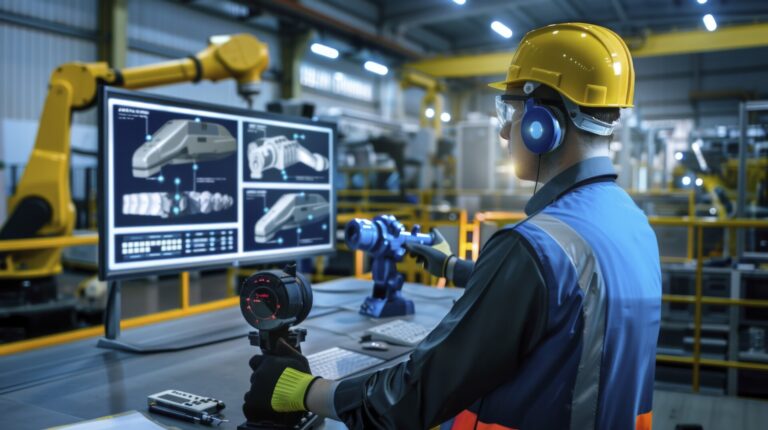Embracing the Future of Manufacturing
What is Digitalization in Manufacturing?
Digitalization in manufacturing refers to the integration of advanced digital technologies into every aspect of the production process, from design and development to operations and supply chain management. It goes beyond simply converting analog systems to digital formats, focusing on leveraging data and automation to create smarter, more efficient workflows.
Why Is Digitalization Important Today?
In today’s fast-paced and competitive market, manufacturers face growing pressure to increase efficiency, reduce costs, and adapt quickly to changing demands. Digitalization addresses these challenges by enabling real-time decision-making, improving product quality, and fostering innovation. It’s the driving force behind the evolution of traditional manufacturing into a connected, intelligent ecosystem.
How Does Digitalization Transform Manufacturing?
By incorporating technologies such as the Internet of Things (IoT), artificial intelligence (AI), and advanced analytics, digitalization transforms static processes into dynamic, data-driven systems. This transformation not only boosts productivity but also unlocks new opportunities for customization, predictive maintenance, and supply chain optimization.
In essence, digitalization empowers manufacturers to stay ahead in an era defined by innovation and agility.
Understanding Digitalization in Manufacturing: Unlocking Smart Solutions
Digitalization vs. Digitization: What’s the Difference?
While they may sound similar, digitalization and digitization are distinct concepts:
- Digitization refers to the process of converting analog information into digital formats. For example, scanning paper documents or replacing physical records with digital files.
- Digitalization, on the other hand, is the next step. It involves leveraging digital technologies to transform and optimize business operations. In manufacturing, this means integrating tools like IoT and AI to create smarter, more efficient systems.
Core Components of Digitalization in Manufacturing
Digitalization in manufacturing isn’t about adopting one technology—it’s about creating a network of interconnected tools and processes. Here are the key pillars driving this transformation:
- IoT (Internet of Things):
Connects machines, sensors, and devices to enable real-time monitoring and seamless communication across the production floor. - Big Data and Analytics:
Helps manufacturers gather and analyze massive amounts of data to uncover trends, optimize processes, and make data-driven decisions. - Artificial Intelligence (AI) and Machine Learning (ML):
AI-powered algorithms enable predictive maintenance, quality control, and even product design, while ML continuously improves system performance. - Automation and Robotics:
Streamlines repetitive tasks, enhances precision, and increases productivity by automating complex manufacturing processes. - Cloud Computing:
Provides scalable storage, real-time collaboration, and access to critical data anytime, anywhere, fostering agility and flexibility.
Together, these technologies create a robust foundation for manufacturers to innovate, compete, and thrive in an increasingly digital world.
Benefits of Digitalization in Manufacturing: Driving Excellence
Why Should Manufacturers Embrace Digitalization?
Digitalization is more than a trend—it’s a transformative force redefining how manufacturers operate, innovate, and compete. By adopting advanced digital technologies, manufacturers can unlock new levels of efficiency, agility, and customer satisfaction. Here’s how digitalization is revolutionizing the industry:
1. Increased Efficiency and Productivity
Automation of repetitive tasks, optimization of resources, and real-time monitoring through IoT devices ensure seamless operations. For instance, smart sensors detect inefficiencies instantly, allowing for swift adjustments that minimize downtime and maximize output.
2. Smarter Decision-Making with Data-Driven Insights
Advanced analytics transform raw data into actionable insights. Manufacturers can identify trends, reduce waste, and optimize operations by adapting strategies to evolving market demands. For example, analyzing energy usage can uncover opportunities for cost-saving improvements.
3. Improved Product Quality and Customization
AI and IoT technologies allow real-time quality control, detecting defects early to maintain high standards while minimizing waste. Digitalization also enables mass customization, meeting consumer demands for personalized products without compromising efficiency.
4. Cost Reduction Through Predictive Maintenance
By analyzing data from IoT sensors, predictive maintenance identifies potential equipment issues before they lead to costly breakdowns. This proactive approach reduces downtime, enhances productivity, and extends equipment lifespan.
5. Supply Chain Transparency and Agility
Digitalization connects supply chain operations, providing real-time tracking and visibility. This allows manufacturers to anticipate and address disruptions efficiently, such as rerouting shipments to avoid delays or adjusting inventory to meet sudden demand spikes.
Digitalization equips manufacturers with the tools to remain competitive and agile in a fast-changing market. It’s not just about process improvements; it’s about building a resilient, future-ready business that thrives on innovation.
Key Technologies Driving Digitalization in Manufacturing
Digitalization in manufacturing is powered by a range of advanced technologies that enhance efficiency, optimize processes, and foster innovation. Here’s a closer look at the key technologies driving this transformation:
1. Internet of Things (IoT):
IoT connects machines, sensors, and devices, creating a network that collects and monitors data in real time. This interconnected system provides actionable insights for predictive maintenance, enabling manufacturers to address potential equipment failures before they occur, reducing downtime, and ensuring seamless operations.
2. Artificial Intelligence (AI) and Machine Learning (ML):
AI and ML are revolutionizing manufacturing by enabling intelligent systems that learn and adapt over time. AI-powered algorithms are used in quality control, identifying defects with precision. Predictive analytics leverage ML to anticipate demand, optimize inventory, and improve supply chain efficiency. Additionally, AI-driven process automation streamlines complex tasks, boosting productivity.
3. Big Data and Analytics:
The vast amount of data generated in manufacturing can be harnessed to identify trends, improve processes, and enhance decision-making. Advanced analytics tools process this data to uncover inefficiencies, predict outcomes, and optimize workflows. Real-world case studies highlight how companies have used analytics to reduce costs and improve production speed.
4. Additive Manufacturing (3D Printing):
Additive manufacturing has transformed prototyping by enabling rapid production of models and designs. It also supports on-demand production, reducing the need for large inventories and allowing for customized product manufacturing with minimal waste.
5. Cloud Computing:
Cloud-based platforms offer centralized data storage, improving collaboration across departments and geographic locations. The scalability of cloud solutions allows manufacturers to expand operations easily while maintaining access to critical data and applications in real time.
Together, these technologies create a synergistic ecosystem that propels manufacturers toward greater agility, efficiency, and innovation.
Challenges of Digitalization in Manufacturing: Overcoming the Roadblocks
While digitalization offers immense benefits, it also comes with challenges that manufacturers must address to fully realize its potential. Here’s a closer look at the key obstacles and how they impact the journey toward digital transformation:
1. High Initial Investment and Infrastructure Requirements
Adopting advanced technologies often involves significant upfront costs, including purchasing new equipment, upgrading facilities, and implementing cutting-edge software. For smaller manufacturers, these expenses can be daunting. However, the long-term gains—such as increased efficiency and reduced operational costs—often outweigh the initial investment, making it a strategic necessity.
2. Cybersecurity Concerns with Interconnected Systems
As manufacturing processes become more connected through IoT and cloud platforms, they also become more vulnerable to cyber threats. A single breach could disrupt production, compromise sensitive data, or damage trust with partners and customers. To mitigate these risks, manufacturers need to prioritize robust cybersecurity measures, including encryption, regular audits, and employee training.
3. Workforce Adaptation and Skills Gap
Digitalization requires a workforce skilled in handling advanced technologies like AI, robotics, and big data analytics. Unfortunately, many employees may lack the technical expertise needed for this transition. Bridging the skills gap involves investing in training programs, upskilling existing employees, and attracting tech-savvy talent to lead the charge.
4. Integration Complexities with Legacy Systems
Manufacturers often rely on legacy systems that were not designed to integrate with modern digital tools. Transitioning to interconnected systems can be a complex process, requiring time, resources, and careful planning. Strategic partnerships with technology providers and gradual integration strategies can help ease this challenge.
Despite these hurdles, the benefits of digitalization far outweigh the challenges, positioning manufacturers for long-term growth and success in an increasingly competitive market.
Steps to Embrace Digitalization in Manufacturing: Your Roadmap to Success
The path to digitalization can seem overwhelming, but with a structured approach, manufacturers can seamlessly transition to a future of enhanced efficiency and innovation. Here’s how to begin:
1. Conduct a Digital Readiness Assessment
Start by evaluating your current infrastructure and systems. A digital readiness assessment helps identify strengths, gaps, and areas that need improvement, ensuring you’re prepared to adopt new technologies strategically.
2. Set Clear Goals and KPIs for Digital Transformation
Define your digital transformation objectives, whether it’s boosting production efficiency, reducing downtime, or improving product quality. Establishing measurable goals and Key Performance Indicators (KPIs) will help you stay focused, track progress, and adjust strategies to meet your targets.
3. Develop a Phased Implementation Plan
Digital transformation is a gradual process. Break down your plan into phases, beginning with pilot projects or areas where technology can have the greatest immediate impact. This approach reduces risks, allows for testing, and ensures a smoother integration of new technologies into existing operations.
4. Partner with Technology Providers or Consultants
Navigating digitalization requires expertise. Partnering with trusted technology providers or consultants ensures you’re selecting the right solutions and implementing them effectively. Their experience can accelerate your transformation and help you leverage the best tools for your needs.
5. Train and Upskill the Workforce
A successful digital transformation depends on a skilled workforce. Invest in training programs to ensure your team is equipped to handle new technologies. Fostering a culture of continuous learning helps employees stay adaptable and confident in their roles, driving innovation across the organization.
By following these steps, manufacturers can navigate digitalization effectively and establish a strong foundation for long-term success in an evolving market.
Examples of Digitalization in Action: Real-World Success Stories
Digitalization is transforming manufacturing in ways that were once unimaginable. From enhanced production processes to improved customer experiences, companies are harnessing digital technologies to revolutionize their operations. Here are a few inspiring examples of digitalization in action:
1. Improved Production Processes
A global automotive manufacturer embraced IoT sensors across its production line, enabling real-time monitoring of machine performance. This smart system quickly detected inefficiencies, allowing for immediate adjustments that reduced downtime and maximized output. As a result, the company improved production efficiency by 25%, driving significant cost savings and faster time-to-market.
2. Enhanced Customer Satisfaction Through Customized Products
A leading consumer goods company integrated AI and 3D printing to offer customers personalized products on-demand. Using AI algorithms, they analyzed customer preferences and tailored designs to individual tastes. This digitalized approach not only reduced inventory costs but also boosted customer satisfaction by offering unique, customizable products—creating a more personalized and engaging customer experience.
3. Real-World Applications of Predictive Maintenance and AI
One industrial equipment manufacturer implemented predictive maintenance through IoT sensors that monitored machinery health in real time. This allowed them to predict failures before they happened, avoiding costly breakdowns and minimizing production disruptions. At the same time, they used AI-driven algorithms to optimize inventory management, ensuring they had the right parts on hand at the right time, reducing delays and excess stock.
The Future of Digitalization in Manufacturing: Embracing Tomorrow’s Innovations
The manufacturing industry is entering a technological revolution powered by digitalization and emerging trends. Several key innovations are shaping the future of production, promising more efficiency, flexibility, and sustainability. Here’s what’s on the horizon:
1. Smart Factories and Industry 4.0
Smart factories, driven by IoT, AI, and automation, are transforming production systems. Industry 4.0 enables factories to become self-optimizing, responding to real-time changes in demand, supply, and capacity. This shift not only enhances efficiency and precision but also provides greater flexibility for product customization and faster time-to-market.
2. Integration of 5G Technology
5G technology will revolutionize manufacturing with its ultra-fast, low-latency communication. This will enhance real-time monitoring, improve automation, and support advanced applications like augmented reality (AR) for training and maintenance. By enabling seamless data transmission, 5G will boost operational efficiency and create more agile, responsive manufacturing processes.
3. The Potential Impact of Quantum Computing
Though still emerging, quantum computing offers immense potential for manufacturing. Its ability to process vast data sets at unprecedented speeds could unlock breakthroughs in areas like supply chain optimization, material science, and design. Quantum computing may revolutionize production planning, R&D, and problem-solving, transforming how manufacturers approach complex challenges.
4. Sustainability and Green Manufacturing
Digitalization is helping manufacturers embrace sustainability by optimizing energy use, reducing waste, and improving resource efficiency. AI and big data analytics are key tools in reducing carbon footprints, while automation streamlines processes for greener operations. Digital tools will be instrumental in tracking and improving environmental impact, driving green initiatives across industries.
Conclusion: Embrace the Future of Manufacturing with Digitalization
Digitalization is no longer just an option—it’s a game-changing force that’s transforming the manufacturing industry. From smarter factories and AI-driven efficiency to sustainability initiatives and real-time data insights, the opportunities are limitless. Manufacturers who embrace these technologies not only improve their operations but also unlock new avenues for innovation and competitiveness.
The future is digital, and those who adapt now will be best positioned to lead in the evolving market. Whether it’s through enhanced productivity, better quality control, or personalized customer experiences, digital transformation offers the tools to stay ahead of the curve.
At ML Digital Marketing, we specialize in helping businesses navigate their digital transformation journey. If you’re ready to leverage digital technologies for competitive advantage, we encourage you to consult with our experts. Our tailored strategies will guide your business toward a more efficient, innovative, and sustainable future.
Take the first step today—consult with us and start your digital transformation journey with confidence!
FAQs
1. What is digitalization in manufacturing?
It’s the use of digital technologies like IoT, AI, and automation to improve production processes and enable real-time decision-making.
2. How does digitalization benefit manufacturers?
It boosts efficiency, reduces costs, improves quality, and enables faster decision-making, customization, and predictive maintenance.
3. What technologies drive digitalization in manufacturing?
Key technologies include IoT, AI, Machine Learning, big data, robotics, and cloud computing.
4. How can manufacturers start their digital transformation?
Begin by assessing systems, setting goals, creating a phased plan, partnering with experts, and training staff.
5. Why is digitalization important for the future of manufacturing?
It helps manufacturers stay competitive, innovate faster, and respond to market changes while supporting sustainability.
6. How can ML Digital Marketing assist with digital transformation?
We offer expert guidance to help businesses adopt digital technologies, optimize operations, and achieve their transformation goals.


